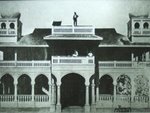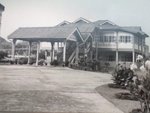[Note: I found this article on our national food 'Ambuyat' written for Denver Post by John Henderson and syndicated on the The Times of Zambia (of all place!)]
If Bruneians want to expand tourism, they’ll need to hide their national speciality.
I saw the sultan of Brunei the other day. He walked right by me as he entered a national Qur’an reading contest.
I wanted to ask the sultan a key question about his country’s cuisine: Hey, sultan, why can’t a man worth 22-billion, whose 400-million palace has a 110-car garage and 257 bathrooms, afford a better national dish?
It’s called ambuyat. Don’t look for it at an ethnic restaurant near you soon. It’s not going anywhere, and it’s here for reasons only historians and the streets’ starving cats can appreciate.
After four days in Brunei, I’d describe ambuyat (pronounced om-BOO-yacht) as a big pile of gelatinous, transparent goo dipped in coagulating blood.
First, a little background. During World War II occupation, the Japanese controlled Brunei’s rice paddies and cut off the food supply. One of the lone food sources was found inside the sago trees that fill Brunei’s jungles.
For centuries the Penan people, an indigenous, nomadic tribe who roam the jungles of Borneo, have lived off the sago tree. They still do. During a three-day trek through the jungles of Malaysian Borneo, I came across a Penan family squatting next to a stack of sago pulp.
They put what looked like leafy sawdust in a wooden bowl the size of a rubbish bin and pounded it into small chunks. They then mix it with hot water and the result is a starchy mass that has all the daily nutrients of raw lard.
Brunei, however, has advanced a bit since World War II. With the discovery of oil in 1929, Shell and the beloved sultan have put petrol in every pot. Shaped like two humps on a camel and occupying a small corner of Borneo’s northwest coast, Brunei has gone from a backwater British protectorate to a thriving Islamic republic of 375000 people with a glittering capital and prosperous economy.
Don’t believe me? What’d you pay for petrol this week? Exactly.
The sultan wants to expand tourism, and while he won’t open Hard Rock Brunei any time soon, he is promoting his country’s history. Part of that history is ambuyat. Tourism has grown 7% a year. I’m assuming ambuyat has nothing to do with it.
To try ambuyat, I went to a food-court stall where it was not pictured among the 31 dishes on the menu. No wonder. A picture in focus would scare off wharf rats.
Two young female cooks invited me into the kitchen to watch the process. It was little different from how the Penans make it. Ema poured a bag of sago that looked like blue-cheese crumbles into a pot of boiling water. She stirred for 60 seconds.
She handed me the result and the necessary dipping sauce, binjai, a gross mixture of chillies, salt and what looked like last week’s tomato soup. Hunks of bulbous matter floated in an orange- brown sea of repugnant fluids.
I was handed chopsticks , around which I was to twist the gooey ambuyat and then dip into the sauce.
The slimy mess slid down my throat like crushed, larvae-coated insect embryos. The sour binjai made my face wrinkle as if I woke up in a dairy farm. I looked over, and a young woman in a head scarf couldn’t stop laughing.
I tried it without the sauce and the ambuyat had no taste. None. But without the lubricating sauce, it nearly stuck halfway down my throat.
So hats off to Brunei for surviving World War II, where ambuyat was probably a tougher obstacle than the Japanese. But if the sultan invites you to the palace, forget the five swimming pools and 564 chandeliers. If ambuyat is on his menu, don’t go.
Welcome to my private journal generally on Brunei issues. Any opinions expressed are in my personal capacity. All rights to the articles are reserved.
Sunday, June 22, 2008
Subscribe to:
Post Comments (Atom)












No comments:
Post a Comment